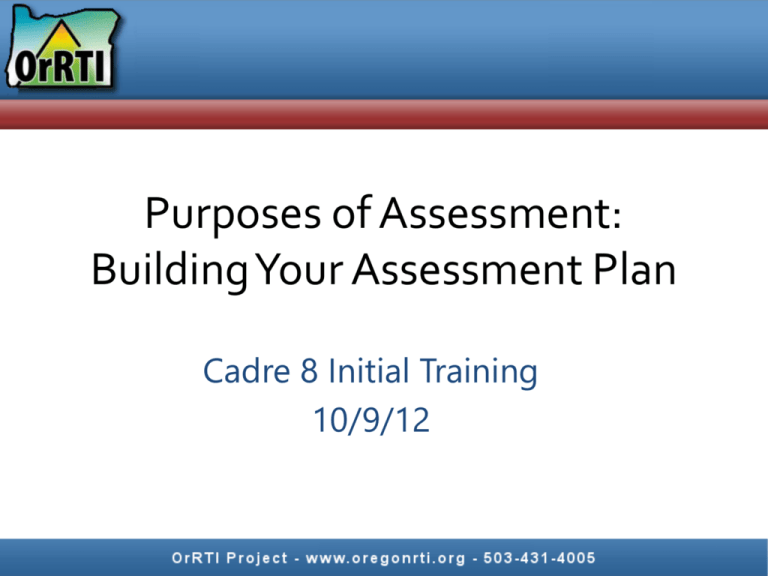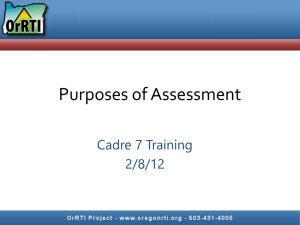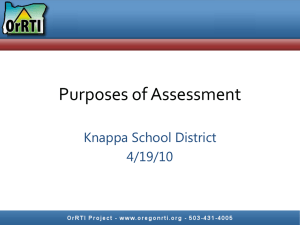Reading
advertisement

Purposes of Assessment: Building Your Assessment Plan Cadre 8 Initial Training 10/9/12 Where We’ve Been • Helped to identify your standards of practice for your core instruction. Where We’re Going • We are now going to help you to understand the purposes of assessment. Targets 1. Team members will have a clear understanding of the four purposes of assessment 1. 2. 3. 4. 2. Screening (formative) Progress Monitoring (formative) Diagnostic (formative) Outcome (summative) District Assessment Plan by the end of day 2 Develop an Assessment Plan Purpose Screening Progress Monitoring Diagnostic Outcome Assessment Big Idea(s) Tested Who is Tested Frequency Who Administers /Types of Reporting What assessments are you currently using in your district? • Take 5 minutes and in your district teams brainstorm a list of all the different assessments your district is currently using • Save the list-we will be revisiting it periodically throughout the presentation Assessment Plan Purpose Screening Progress Monitoring Diagnostic Outcome Assessment Big Idea(s) Tested Who is Tested Frequency Who Administers /Types of Reporting Screening Targets • Build conceptual understanding about universal screeners – To develop standards of practice for universal screening • Determine professional development needs for universal screening Universal Screening: Standards of Practice Universal Screening “The Bang for the Buck” Universal Screening Tools Brief & Easy Frequent Sensitive to growth Indicator of overall health Equivalent forms!!! A universal screener should over-identify students who might need something more! What are “better” skills to screen? Basic Skills – Finite • Phonemic awareness • Decoding/phonics • Fluency Comprehensive Skills – Not finite • Vocabulary • Comprehension What are some commonly used screening tools? Reading AIMSWEB Reading CBM, Maze DIBELS NEXT FSF, PSF, NWF, ORF, Daze easyCBM PSF, LSF, WRF, PRF, MC Reading Comp, Vocab Math AIMSWEB M – Computation, M – Concepts & Applications, CBM – Early Numeracy easyCBM Numbers & Operations, Measurement, Geometry, Algebra Written Language Writing – CBM (Total Words Written, Correct Writing Sequences, Words Spelled Correctly) What are NOT good screening tools? Reading •Quick Phonics Assessment •Report Cards •OAKS •DRA •Running Records •QRI •Fountas & Pinnell •Reading curriculum weekly or monthly tests or fluency passages Math Curriculum weekly tests Teacher created math probes* OAKS Written Language Writing rubrics* OAKS * when not administered and scored in a standardized and reliable way, or checked for consistency of multiple probes Why give Universal Screeners? 1. To determine the health of the core • Make instructional changes to improve core instruction 2. To identify students who need additional instructional support – Are staff using the screening data for BOTH these reasons? 1) Are staff using screening data to determine the health of the core? School-wide (100%) grade level meetings – Fall, winter, spring (following screening) Outcome: Increase overall achievement – what to teach – how to teach Strong core instruction Weak Core Instruction Setting Criteria: Schoolwide Meetings Do you have criteria around how to know if your core instruction is effective? 2) Are staff using screening data to identify students who need interventions? – How are these decisions made? – Are they unbiased? Do you have criteria to determine which students need interventions? Setting Criteria: Identifying Students for Interventions What data do you use? How many students can be supported? What materials do you have? How many staff have been trained on the interventions? Assessments in TTSD Universal Screeners Additional assessments • Elementary • Reading • Elementary – DIBELS Next • Math – AIMSweb • Missing Number (K-1) • Calculations (2-5) Middle School • Reading – AIMSweb (Maze) – Treasures Placement Test – OAKS • Secondary – OAKS Using screening data to identify students for interventions CBM Screening Assessment Core Program Assessment OAKS How many students can you support? 20% 30% 20% 50% Questions to Think About: Screeners • • • • • • Who will administer the screeners? Who will train the screeners? Who will prepare materials? Who will organize materials at the school? Where will the data go? Who will organize the data and present it to teaching teams? • How will fidelity of administration be checked? Troubleshooting: Screeners Is the system sustainable over time? • Do staff trust and use the data? • “it’s all about the numbers” • “it will be used to evaluate my instruction” • How will you communicate the decisions that you have made about Universal Screeners in your district? • How will you monitor the decisions you have made? Screening Purpose Screening Progress Monitoring Diagnostic Outcome Assessment Big Idea(s) Tested Who is Tested Frequency Who Administers /Types of Reporting Assessment Plan Purpose Screening Progress Monitoring Diagnostic Outcome Assessment Big Idea(s) Tested Who is Tested Frequency Who Administers /Types of Reporting Progress Monitoring Tools Brief & Easy Sensitive to growth “Indicator” Frequent Equivalent forms!!! What are some commonly used progress monitoring tools? Reading AIMSWEB Reading CBM, Maze DIBELS NEXT FSF, PSF, NWF, ORF, Daze easyCBM PSF, LSF, WRF, PRF, MC Reading Comp, Vocab Math AIMSWEB M – Computation, M – Concepts & Applications, CBM – Early Numeracy easyCBM Numbers & Operations, Measurement, Geometry, Algebra Written Language Writing – CBM (Total Words Written, Correct Writing Sequences, Words Spelled Correctly) What are NOT good progress monitoring tools? Reading •Phonic Screeners •Report Cards •OAKS •DRA •Running Records •Reading curriculum weekly or monthly tests or fluency passages Math Curriculum weekly tests OAKS Teacher created math probes* Written Language Writing rubrics* OAKS * when not administered and scored in a standardized and reliable way, or checked for consistency of multiple probes Using the Right Tool The progress monitoring tool should match the skills being taught. Additional Progress Monitoring Tools For more info and a review of available tools, visit www.rti4success.org (Progress Monitoring Tools Chart) What information does it give you? Reading Curriculum Fluency Passages/Weekly Tests VS. Progress Monitoring Tools (CBM) What information does it give you? Reading Curriculum Fluency Passages/Weekly Tests VS. Progress Monitoring Tools (CBM) What information does it give you? Reading Curriculum Fluency Passages/Weekly Tests VS. Progress Monitoring Tools (CBM) Assessment Plan Purpose Screening Progress Monitoring Diagnostic Outcome Assessment Big Idea(s) Tested Who is Tested Frequency Who Administers /Types of Reporting Diagnostic Answer the question… Why? Diagnostic assessments may include: • • • • Quick Phonics Screener Survey Level Assessments Error Analysis or Running Records Any formal or informal assessment that answers the question: – Why is the student having a problem? Diagnostic Assessment Questions “Why is the student not performing at the expected level?” “What is the student’s instructional need?” We do not use diagnostic data… …for all students …to monitor progress towards a long-term goal …to compare students to each other Assessment Plan Purpose Screening Progress Monitoring Diagnostic Outcome Assessment Big Idea(s) Tested Who is Tested Frequency Who Administers /Types of Reporting Why use outcome measures? • To determine how well students are doing at the end of an instructional time period (lesson, unit, year) Why use outcome measures? • To determine if a goal was met Examples of Outcome Measures • • • • • • OAKS End of Unit/Program Assessments Stanford Achievement Test DIBELS EasyCBM AIMSweb Final Questions/Comments Where We’ve Been • Helped to develop your understanding or the purposes of assessment. Where We’re Going • We are now going to develop your understanding about how to use data to evaluate and make adjustments to core instruction. Evaluation • Please complete the evaluation for this presentation • Please write down some things you really want to remember on the “Tools and Take Away” Sheet




